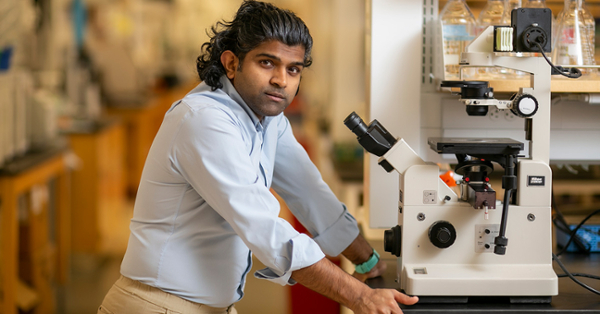Goutham Kodakandla, Ph.D., sets sights on career in academia
Goutham Kodakandla, Ph.D., sets sights on career in academia

In May 2020, Goutham Kodakandla left his job at a Maryland laboratory to enroll in a Rowan University doctoral program—all because of a post he read on the social network X, then called Twitter.
On May 3, with three high-impact, first-author publications on calcium signaling and another on the way, plus a handful of poster presentations at conferences to his name, Kodakandla will formally receive his doctoral hood from his mentor and adviser during Rowan University’s inaugural hooding ceremony in advance of Commencement.
Presently a postdoctoral researcher in the Department of Physiology at the University of Pennsylvania, Kodakandla was the first in his family to receive a four-year college degree, let alone an advanced degree. In addition to his master’s in cell and molecular biology from the University of Missouri-Kansas City, he now holds a Ph.D. in molecular cell biology and neuroscience from the Rowan-Virtua School of Translational Biomedical Engineering & Sciences in the Virtua Health College of Medicine & Life Sciences.
It happened at just the right time.
“One thing people don't talk about in academic research—or any research—is finding the right mentor,” Kodakandla said. He spent four years working in the biotech industry, while calculating his next step.
Already a seasoned experimenter, Kodakandla had long been fascinated by the critical roles calcium plays in the body—or rather, by how much remains unknown.
Years earlier, as a pharmacy and pharmacology undergraduate at Jawaharlal Nehru Technological University in Hyderabad, India, Kodakandla saw how calcium added to a solution made the muscle of a frog contract. While 99 percent of calcium is stored in the body’s teeth and bones, the remaining 1 percent is found in blood and tissue, where the mineral is necessary for muscle contraction, blood clotting, normal heart rhythm and more.
Kodakandla wanted to know more about how calcium transmits signals to cells. “It’s been in my mind for a long time,” Kodakandla said.
So, when the Washington, D.C., resident read a tweet about a chance to join a lab focused on calcium and its role at the cellular level, he traveled to Camden for an interview with Dr. Darren Boehning, professor of biomedical sciences at Cooper Medical School and an expert in calcium and cell death.
From there, “things started happening,” Kodakandla said. He moved to Philadelphia and began jogging early every morning over the Benjamin Franklin Bridge to Boehning’s lab, working for hours in solitude before others arrived.
In the research world, a person who is good at conducting experiments and working with instruments is said to have “good hands.”
“He has some of the best technical skills, or hands, that I’ve ever seen on a student,” Boehning said. “He’s absolutely amazing.” Because he was so experienced, Boehning added, he was “extremely independent, both intellectually and experimentally.”
He was also productive. What Kodakandla and his co-authors discovered over the next three years could one day lead to new drugs for autoimmune diseases.
The body tightly regulates calcium levels in cells. When these levels go awry, cells die or perform functions they should not, leading to disease and dysfunction. To understand how this happens, Kodakandla focused on the ion channel conducting calcium in and out of the cell.
In Boehning’s lab, Kodakandla specifically studied proteins that are extremely important for the function of T-cells, which help protect the body from infection. If these proteins don’t work properly, it leads to autoimmunity, meaning T-cells attack the body instead of invaders.
“Remarkably, he found a completely new way in which they function,” Boehning said. “Not only that, the pathway he identified is druggable. What that means is, we could see the development of brand-new, unheard-of therapeutic targets for this disease because of his discovery of this new pathway that activates these proteins.”
Kodakandla’s dream is to remain in academia, so he can teach and run a research lab. His next task is to secure grant funding for his own project. The promise of uncovering new discoveries continues to drive him.
“Science does not work 99 percent of the time,” Kodakandla said. “But it’s the 1 percent of time that it works—it’s like a high. We all want that 1 percent.”
Every spring, Rowan University highlights one graduating student from each school and college. Read more stories about this year’s featured graduates.